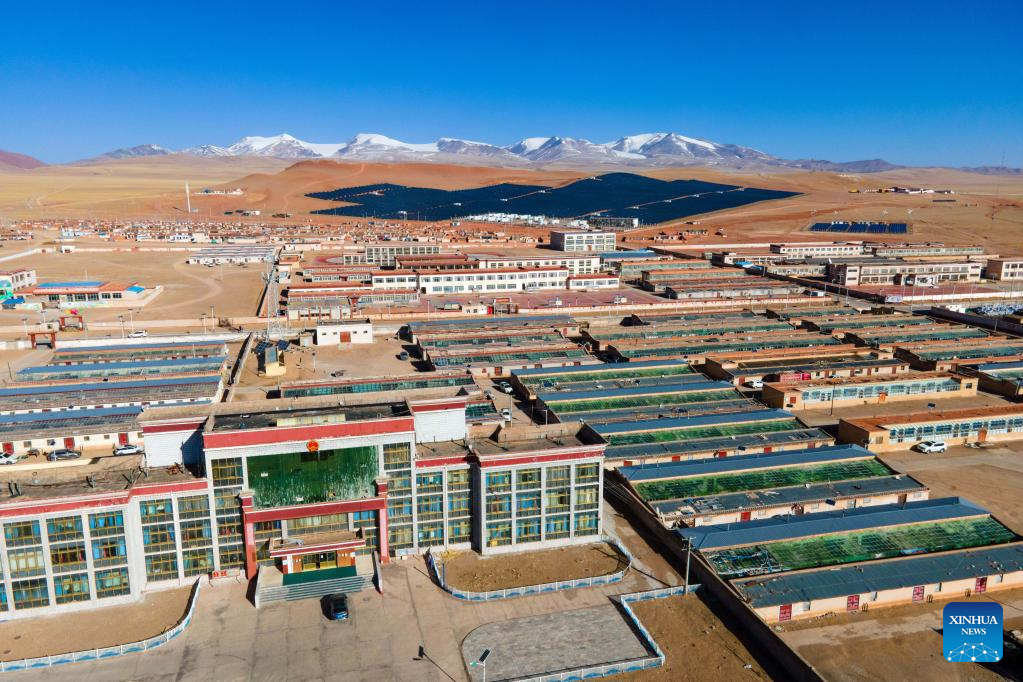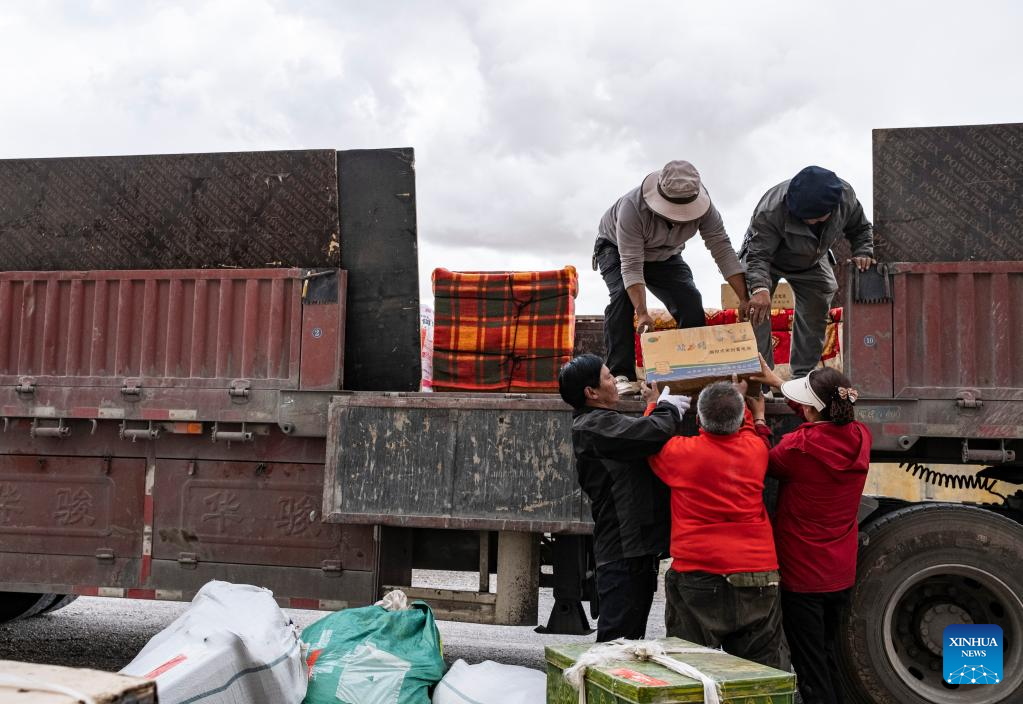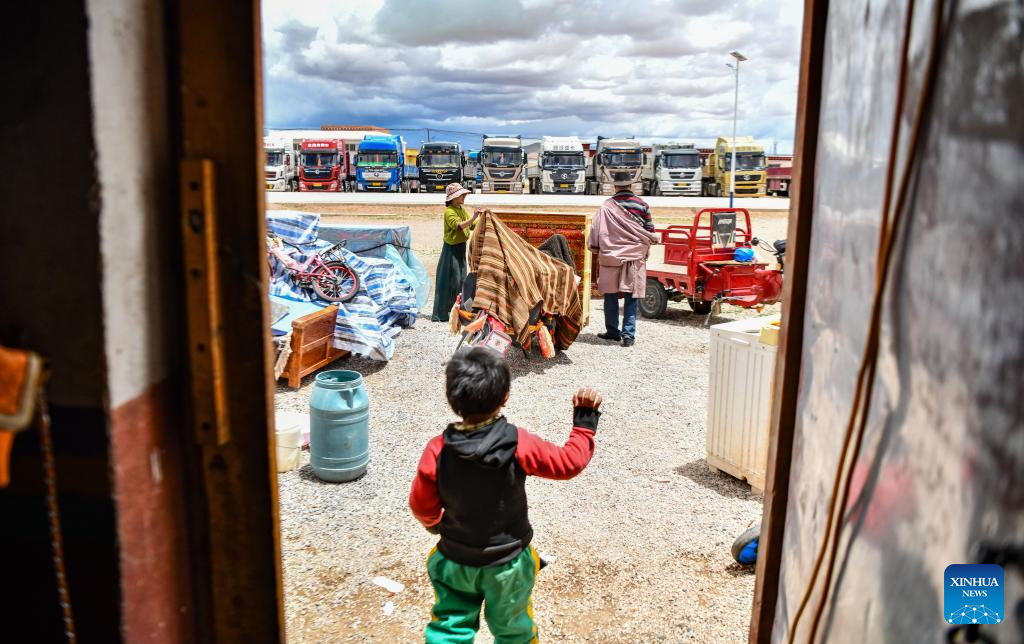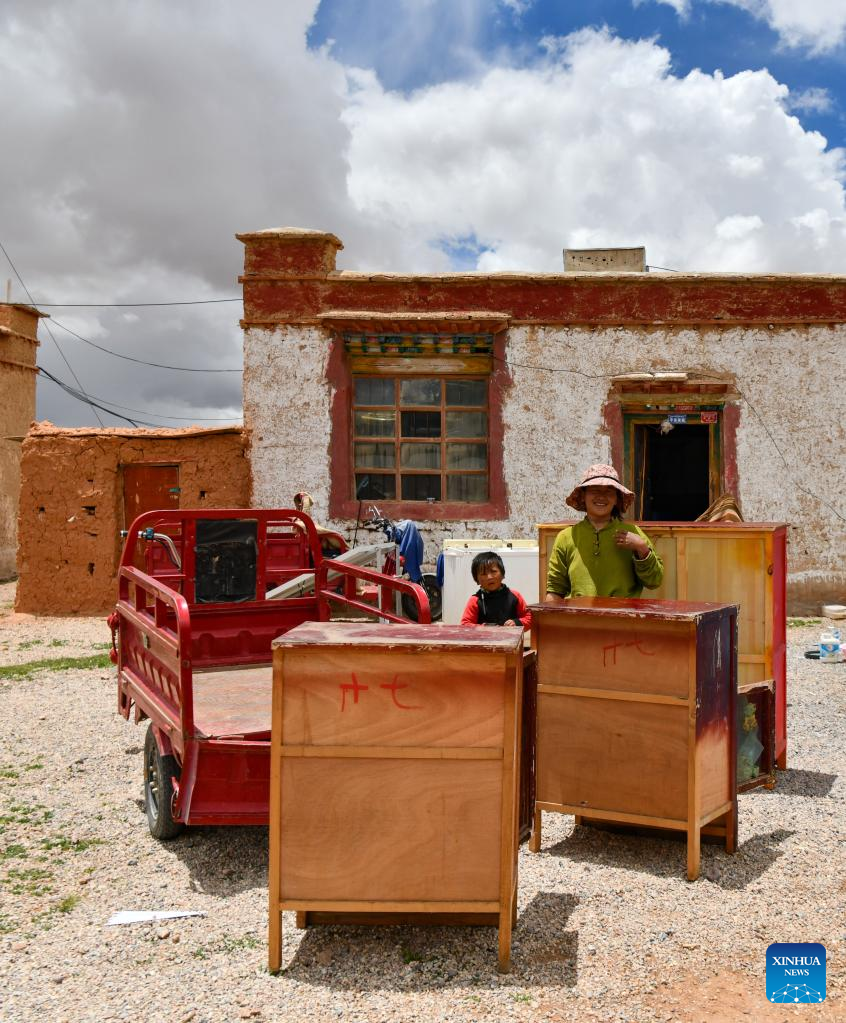
Aerial photo taken on March 27, 2022 shows a view of Tsonyi County, southwest China's Tibet Autonomous Region. Tsonyi County, southwest China's Tibet Autonomous Region, started the relocation of its second batch of residents on Tuesday, as part of the region's plan to improve people's living conditions and protect the fragile local ecosystem.
With an average altitude of over 5,000 meters, Tsonyi County covers a total area of 120,000 square km and is part of the Changtang National Nature Reserve, China's biggest and highest nature reserve.
Due to the high altitude and harsh environment, the county is not suitable for human habitation. The oxygen in the air is a mere 40 percent of that on the plain. Its winter lasts 10 months each year, with the lowest temperatures reaching minus 40 degrees Celsius. (Xinhua/Zhou Dixiao)
LHASA, July 19 (Xinhua) -- Tsonyi, the world's highest county in southwest China's Tibet Autonomous Region, started the relocation of its second batch of residents on Tuesday, as part of the region's plan to improve people's living conditions and protect the fragile local ecosystem.
More than 300 residents left their hometown in the county's Doima Township at around 7:40 a.m. Tuesday, moving nearly 1,000 km southward to their new home Singpori.
Singpori is on the north bank of the Yarlung Zangbo River in the city of Shannan, located at an altitude of 3,600 meters. It is only some 10 km from the airport in the regional capital Lhasa.
Four townships of the county will complete relocation by early August, and by then, all seven townships of Tsonyi, including the three that moved in 2019, will have completed relocation.
"After moving to my new home, I will be able to visit the monasteries in Lhasa and Shannan more frequently to worship Buddha," said Garma, a 70-year-old herder from Doima Township.
With an average altitude of over 5,000 meters, Tsonyi County covers a total area of 120,000 square km and is part of the Changtang National Nature Reserve, China's biggest and highest nature reserve.
Due to the high altitude and harsh environment, the county is not suitable for human habitation.
Tibet relocated the first batch of 2,900 residents in Tsonyi to Singpori in 2019. ■

Photo taken with mobile phone shows buses carrying villagers preparing to depart from Doima Township of Tsonyi County, southwest China's Tibet Autonomous Region, July 19, 2022. Tsonyi County, southwest China's Tibet Autonomous Region, started the relocation of its second batch of residents on Tuesday, as part of the region's plan to improve people's living conditions and protect the fragile local ecosystem.
With an average altitude of over 5,000 meters, Tsonyi County covers a total area of 120,000 square km and is part of the Changtang National Nature Reserve, China's biggest and highest nature reserve.
Due to the high altitude and harsh environment, the county is not suitable for human habitation. The oxygen in the air is a mere 40 percent of that on the plain. Its winter lasts 10 months each year, with the lowest temperatures reaching minus 40 degrees Celsius. (Xinhua/Shen Hongbing)

Villagers load luggage onto a truck in Doima Township of Tsonyi County, southwest China's Tibet Autonomous Region, July 12, 2022. Tsonyi County, southwest China's Tibet Autonomous Region, started the relocation of its second batch of residents on Tuesday, as part of the region's plan to improve people's living conditions and protect the fragile local ecosystem.
With an average altitude of over 5,000 meters, Tsonyi County covers a total area of 120,000 square km and is part of the Changtang National Nature Reserve, China's biggest and highest nature reserve.
Due to the high altitude and harsh environment, the county is not suitable for human habitation. The oxygen in the air is a mere 40 percent of that on the plain. Its winter lasts 10 months each year, with the lowest temperatures reaching minus 40 degrees Celsius. (Xinhua/Sun Fei)

A villager loads furniture onto a truck in Doima Township of Tsonyi County, southwest China's Tibet Autonomous Region, July 12, 2022. Tsonyi County, southwest China's Tibet Autonomous Region, started the relocation of its second batch of residents on Tuesday, as part of the region's plan to improve people's living conditions and protect the fragile local ecosystem.
With an average altitude of over 5,000 meters, Tsonyi County covers a total area of 120,000 square km and is part of the Changtang National Nature Reserve, China's biggest and highest nature reserve.
Due to the high altitude and harsh environment, the county is not suitable for human habitation. The oxygen in the air is a mere 40 percent of that on the plain. Its winter lasts 10 months each year, with the lowest temperatures reaching minus 40 degrees Celsius. (Xinhua/Zhou Dixiao)

Villagers pack their belongings for relocation in Doima Township of Tsonyi County, southwest China's Tibet Autonomous Region, July 12, 2022. Tsonyi County, southwest China's Tibet Autonomous Region, started the relocation of its second batch of residents on Tuesday, as part of the region's plan to improve people's living conditions and protect the fragile local ecosystem.
With an average altitude of over 5,000 meters, Tsonyi County covers a total area of 120,000 square km and is part of the Changtang National Nature Reserve, China's biggest and highest nature reserve.
Due to the high altitude and harsh environment, the county is not suitable for human habitation. The oxygen in the air is a mere 40 percent of that on the plain. Its winter lasts 10 months each year, with the lowest temperatures reaching minus 40 degrees Celsius. (Xinhua/Jigme Dorje)

Aerial photo shows trucks carrying furniture setting off from Doima Township in Tsonyi County, southwest China's Tibet Autonomous Region, July 15, 2022. Tsonyi County, southwest China's Tibet Autonomous Region, started the relocation of its second batch of residents on Tuesday, as part of the region's plan to improve people's living conditions and protect the fragile local ecosystem.
With an average altitude of over 5,000 meters, Tsonyi County covers a total area of 120,000 square km and is part of the Changtang National Nature Reserve, China's biggest and highest nature reserve.
Due to the high altitude and harsh environment, the county is not suitable for human habitation. The oxygen in the air is a mere 40 percent of that on the plain. Its winter lasts 10 months each year, with the lowest temperatures reaching minus 40 degrees Celsius. (Xinhua/Sun Fei)

A villager herds livestock in Doima Township of Tsonyi County, southwest China's Tibet Autonomous Region, July 13, 2022. Tsonyi County, southwest China's Tibet Autonomous Region, started the relocation of its second batch of residents on Tuesday, as part of the region's plan to improve people's living conditions and protect the fragile local ecosystem.
With an average altitude of over 5,000 meters, Tsonyi County covers a total area of 120,000 square km and is part of the Changtang National Nature Reserve, China's biggest and highest nature reserve.
Due to the high altitude and harsh environment, the county is not suitable for human habitation. The oxygen in the air is a mere 40 percent of that on the plain. Its winter lasts 10 months each year, with the lowest temperatures reaching minus 40 degrees Celsius. (Xinhua/Sun Fei)

Villagers are seen on a bus heading for Singpori of Shannan, southwest China's Tibet Autonomous Region, July 19, 2022. Tsonyi County, southwest China's Tibet Autonomous Region, started the relocation of its second batch of residents on Tuesday, as part of the region's plan to improve people's living conditions and protect the fragile local ecosystem.
With an average altitude of over 5,000 meters, Tsonyi County covers a total area of 120,000 square km and is part of the Changtang National Nature Reserve, China's biggest and highest nature reserve.
Due to the high altitude and harsh environment, the county is not suitable for human habitation. The oxygen in the air is a mere 40 percent of that on the plain. Its winter lasts 10 months each year, with the lowest temperatures reaching minus 40 degrees Celsius. (Xinhua/Sun Fei)

Villagers prepare to transport furniture for relocation in Doima Township of Tsonyi County, southwest China's Tibet Autonomous Region, July 12, 2022. Tsonyi County, southwest China's Tibet Autonomous Region, started the relocation of its second batch of residents on Tuesday, as part of the region's plan to improve people's living conditions and protect the fragile local ecosystem.
With an average altitude of over 5,000 meters, Tsonyi County covers a total area of 120,000 square km and is part of the Changtang National Nature Reserve, China's biggest and highest nature reserve.
Due to the high altitude and harsh environment, the county is not suitable for human habitation. The oxygen in the air is a mere 40 percent of that on the plain. Its winter lasts 10 months each year, with the lowest temperatures reaching minus 40 degrees Celsius. (Xinhua/Jigme Dorje)

Aerial photo taken on July 13, 2022 shows trucks carrying furniture preparing to depart from Doima Township of Tsonyi County, southwest China's Tibet Autonomous Region. Tsonyi County, southwest China's Tibet Autonomous Region, started the relocation of its second batch of residents on Tuesday, as part of the region's plan to improve people's living conditions and protect the fragile local ecosystem.
With an average altitude of over 5,000 meters, Tsonyi County covers a total area of 120,000 square km and is part of the Changtang National Nature Reserve, China's biggest and highest nature reserve.
Due to the high altitude and harsh environment, the county is not suitable for human habitation. The oxygen in the air is a mere 40 percent of that on the plain. Its winter lasts 10 months each year, with the lowest temperatures reaching minus 40 degrees Celsius. (Xinhua/Jigme Dorje)



